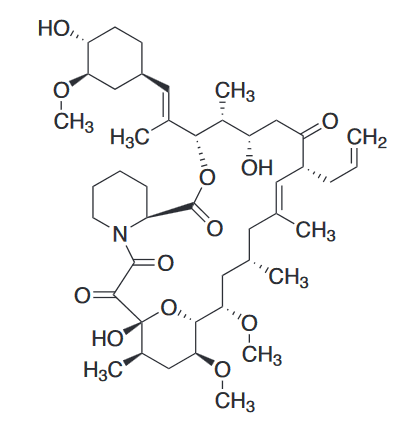FK506
-
Cat.code:
inh-fk5-5
- Documents
ABOUT
Calcineurin Inhibitor and Autophagy Inducer
FK506 (also known as Tacrolimus), a commonly used immunosuppressant, is a potent calcineurin inhibitor. Calcineurin is a calcium-dependent enzyme that activates the cytoplasmic nuclear factor of activated T cell (NFAT) by dephosphorylating it. The activated NFAT is then translocated into the nucleus, where it upregulates the expression of cytokines such as interleukin 2 (IL-2), which, in turn, stimulates the growth and differentiation of the T cell response.
Mode of action:
Similar to cyclosporin A, FK506 blocks the activation of calcineurin through the formation of complexes with immunophilins. FK506 binds to an immunophilin called FK506 binding protein 12 (FKBP12), unlike cyclosporin A which binds to a different immunophilin [1]. The FK506–FKBP12 complex suppresses the activation of the calcineurin-dependent NFAT pathway and the subsequent expression of cytokines, such as IL-2. It has been demonstrated that FK506 also suppresses the calcineurin-independent activation pathway for JNK and p38 [2, 3].
Of note, FK506 has been reported to be an activator of autophagy [4].
Key features:
- A potent calcineurin inhibitor
- An autophagy inducer
- InvitroFit™ grade: each lot is functionally tested
![]() Read our review on Autophagy and Innate Immunity
Read our review on Autophagy and Innate Immunity
References:
1. Powell J.D. & Zheng Y., 2006. Dissecting the mechanism of T-cell anergy with immunophilin ligands. Curr Opin Investig Drugs. 7(11):1002-7.
2. Matsuda S. et al., 2000. Two distinct action mechanisms of immunophilin-ligand complexes for the blockade of T-cell activation. EMBO Rep. 1(5):428-34.
3. Vafadari R. et al., 2012. Inhibitory Effect of Tacrolimus on p38 Mitogen-Activated Protein Kinase Signaling in Kidney Transplant Recipients Measured by Whole-Blood Phosphospecific Flow Cytometry. Transplantation. 93(12):1245-51.
4. Kim D. et al., 2017. FK506, an immunosuppressive drug, induces autophagy by binding to the V-ATPase catalytic subunit A in neuronal cells. J. Proteome Res. 16, 55–64.
All products are for research use only, and not for human or veterinary use.
InvitroFit™
InvitroFit™ is a high-quality standard specifically adapted for in vitro studies of inhibitors. InvitroFit™ products are highly pure (≥95%) and guaranteed free of bacterial contamination, as confirmed using HEK Blue™ TLR2 and HEK Blue™ TLR4 cellular assays. Each lot is rigorously tested for functional activity using validated (or proprietary) cellular models. This grade ensures reliability and reproducibility for your research applications.
SPECIFICATIONS
Specifications
C44H69NO12
100 mg/ml in DMSO
1 - 100 nM
Negative (tested using EndotoxDetect™ assay)
In vitro cellular assays
Each lot is functionally tested and validated using cellular assays.
Details
Calcineurin
Calcineurin, also known as protein phosphatase 2B, is a calcium-dependent serine/threonine protein phosphatase that is involved in many numerous cell signaling pathways [1]. It is activated by increases in intracellular calcium concentrations, a process that requires the binding of the calcium-sensing protein calmodulin to a recognition region within calcineurin's regulatory domain.
Calcineurin has the ability to dephosphorylate a broad range of proteins. Notably, calcineurin induces transcription factors (NFATs) that are important in the transcription of IL-2 genes. IL-2 activates T-helper lymphocytes and induces the production of other cytokines. In this way, it governs the action of cytotoxic lymphocytes [1]. Other transcription factor substrates regulated by dephosphorylation by calcineurin include the forkhead transcription factors (FOXO), myocyte-specific enhancer factor 2 (MEF2), and transcription factor EB (TFEB) [2-4]. These transcription factors regulate a wide variety of processes including metabolism and autophagy.
References:
1. Baksh S. et al., 2000. The role of calcineurin in lymphocyte activation. Semin Immunol. 12(4):405-15.
2. Li H. et al., 2011. Interaction of calcineurin with substrates and targeting proteins. Trends Cell Biol. 21(2):91-103.
3. Shimizu H. et al., 2017. The Calcineurin-FoxO-MuRF1 signaling pathway regulates myofibril integrity in cardiomyocytes. Elife. 6:e27955.
4. Li J. et al., 2013. Regulation of MEF2 transcriptional activity by calcineurin/mAKAP complexes. Exp Cell Res. 319(4):447-54.
Chemical structure of FK506:

CONTENTS
Contents
-
Product:FK506
-
Cat code:inh-fk5-5
-
Quantity:5 x 10 mg
FK506 is provided as a translucent film.
Shipping & Storage
- Shipping method: Room temperature
- -20 °C
- Avoid repeated freeze-thaw cycles
Storage:
Caution:
DOCUMENTS
Documents
Technical Data Sheet
Safety Data Sheet
Validation Data Sheet
Certificate of analysis
Need a CoA ?





